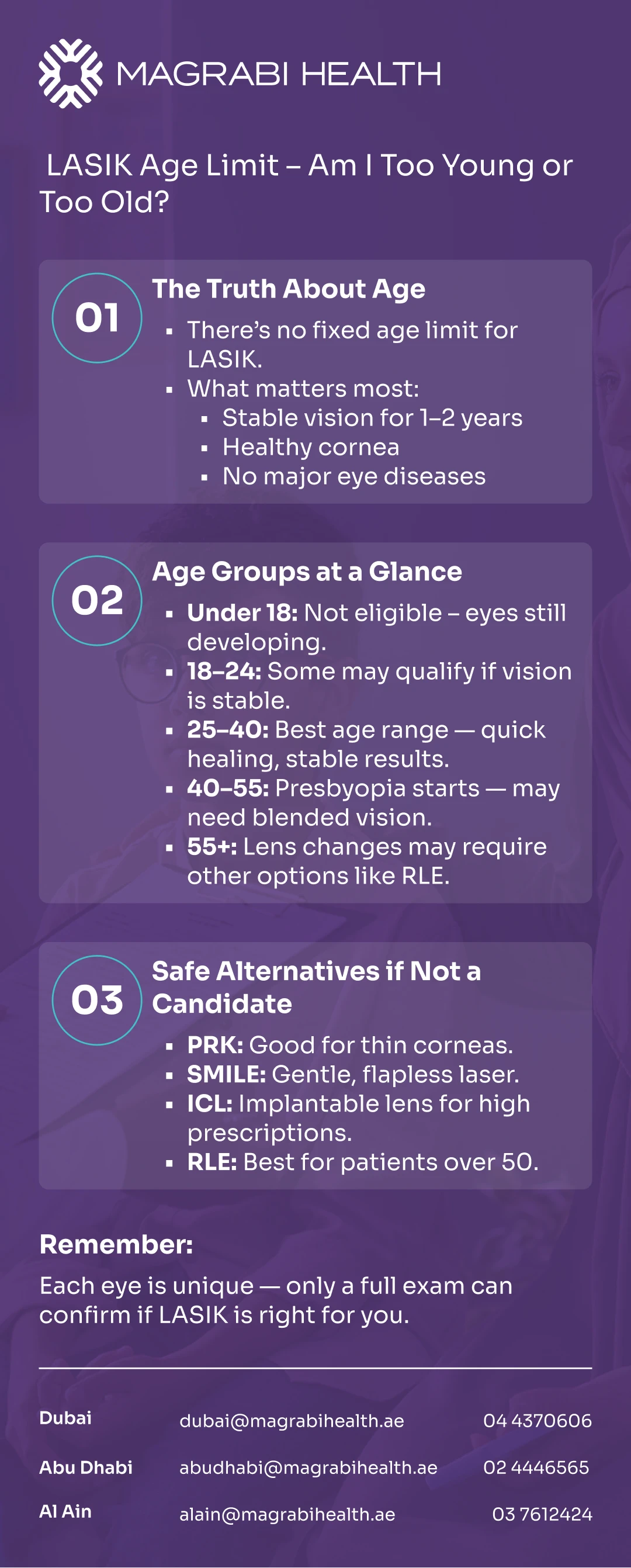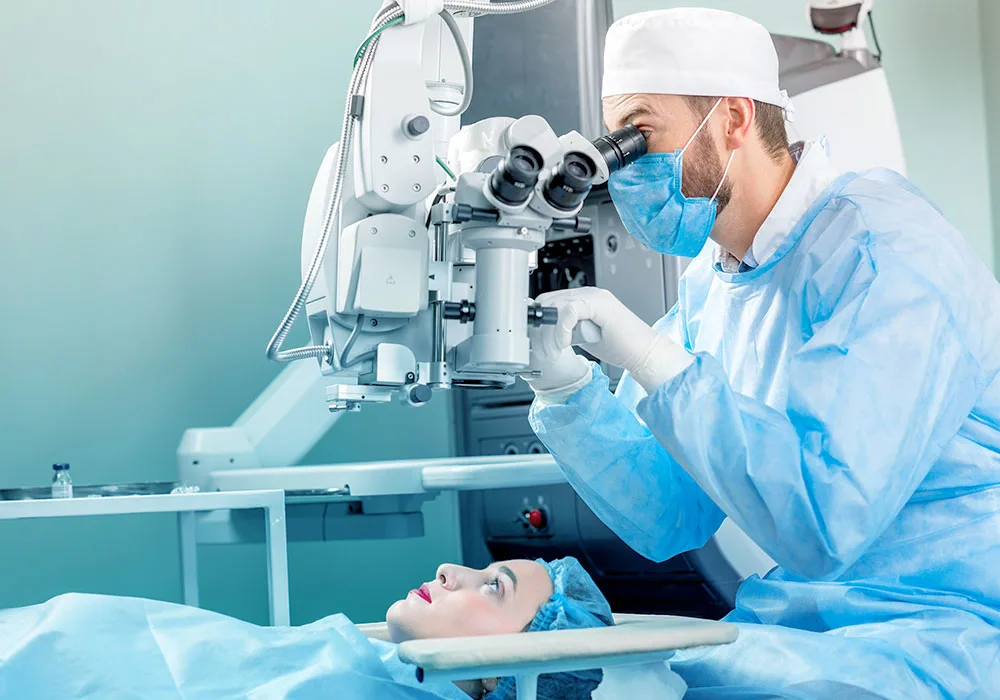When people search LASIK Age Limit, they often wonder if age alone determines whether they can safely undergo laser vision correction. The truth is, there’s no strict upper or lower age limit. What really matters is the stability of your prescription, the health of your cornea, and your overall eye condition.
This article explains the safe age ranges for LASIK, how eligibility changes across life stages, and what doctors consider before recommending surgery — so you can make an informed decision with confidence and expert guidance.
Not sure if LASIK is right for you? Book your consultation today with Magrabi’s trusted specialists.
Age alone doesn’t decide whether someone can have LASIK.
Ophthalmologists look at a combination of medical factors to ensure your eyes are ready for safe, stable results.
The most important elements are prescription stability, corneal shape and thickness, tear film quality, and overall eye health.
Understanding these helps you see why two people of the same age might have completely different LASIK recommendations.
Before listing these factors, it’s worth noting that no two eyes are alike.
Prescription stability: Your glasses or contact lens prescription should remain unchanged for at least 12–24 months.
Corneal thickness and shape: Adequate thickness is needed for safe reshaping; irregularities like keratoconus can disqualify LASIK.
Tear film quality: Dry eyes increase discomfort and delay healing, so tear evaluation is critical.
Pupil size: Larger pupils may cause glare or halos in dim light.
General eye health: Conditions like cataract, inflammation, or uncontrolled diabetes must be ruled out first.
At Magrabi Health, ophthalmology specialists carefully review all these factors before confirming whether LASIK—or an alternative like SMILE or PRK—is the safest option for each patient.

The ideal LASIK Age Limit isn’t defined by a single number — it’s shaped by how the eyes change over time. Each life stage brings unique visual needs and anatomical considerations, and ophthalmologists tailor their recommendations accordingly.
Teenage eyes are still developing, and prescriptions often fluctuate. Doctors typically wait until adulthood and documented stability before considering LASIK.
This is the transition zone. Some candidates qualify if their vision has remained stable for at least 1–2 years. If fluctuations persist, temporary solutions like PRK or continued lenses may be advised.
Most successful LASIK cases occur here. Refraction is usually stable, corneas are strong, and healing is quick. With proper screening, outcomes are highly predictable.
Natural near-vision decline begins, so monovision LASIK or blended correction may be discussed. Doctors also factor in daily visual habits, such as reading or screen use.
At this stage, changes in the eye’s natural lens and tear film become more relevant. For some, lens-based procedures like RLE or cataract surgery with premium IOLs may be safer than LASIK.
Each recommendation is based not just on age, but on the biological “age” of the eyes—something only a detailed eye exam can reveal.
Learn more about LASIK candidacy and age-related vision solutions on our LASIK and Vision Correction page.
If your eyes don’t meet the criteria for LASIK due to age, corneal thickness, or stability issues, several proven alternatives can still help you achieve clearer vision safely.
Your ophthalmologist will guide you toward the procedure that leading matches your eye anatomy and visual goals.
A surface laser technique ideal for patients with thinner corneas or those involved in contact sports. Healing takes longer than LASIK, but long-term results are comparable.
A flapless laser procedure that may reduce dry-eye symptoms and preserve corneal strength. Suitable for moderate myopia and certain astigmatism ranges.
A reversible option where a biocompatible lens is implanted inside the eye without reshaping the cornea. Often chosen for high prescriptions or thin corneas.
A lens-based procedure recommended for patients over 50 or those developing early cataracts. It replaces the natural lens with an advanced intraocular lens (IOL) for long-term clarity.
At Magrabi Health, ophthalmologists evaluate each case individually to recommend the safest and most effective vision correction method—whether laser-based or lens-based.
There’s no single number that defines the LASIK Age Limit what truly matters is the health, stability, and readiness of your eyes.
With proper screening, many adults whether in their 20s, 40s, or even 60s can safely benefit from laser vision correction.
At Magrabi Health, every recommendation is personalized, balancing technology, safety, and long-term clarity to ensure you make the leading decision for your vision.
Discover the right time for LASIK — book your consultation today with Magrabi’s trusted specialists in the UAE.
American Academy of Ophthalmology (AAO) – LASIK Eye Surgery: Candidate Age and Eligibility Guidelines.
Mayo Clinic – LASIK Eye Surgery: Procedure, Risks, and Results.
Cleveland Clinic – LASIK: Who Is a Good Candidate and What to Expect by Age.
NHS (UK National Health Service) – Laser Eye Surgery: Age Limits, Risks, and Long-Term Safety.
U.S. Food and Drug Administration (FDA) – LASIK Patient Information and Checklist.
This article is intended for educational purposes only and should not be used as a substitute for professional medical advice, diagnosis, or treatment. Always consult a certified ophthalmologist to determine the leading vision correction option for your eyes.
Dr. Tamer Gamaly
Consultant Ophthalmologist – LASIK & Vision Correction Specialist
Magrabi Health UAE

Ultra LASIK vs Femto LASIK: Which One Is Right for Your Eyes?

LASIK Eye Surgery Cost in the UAE: What Really Affects the Price